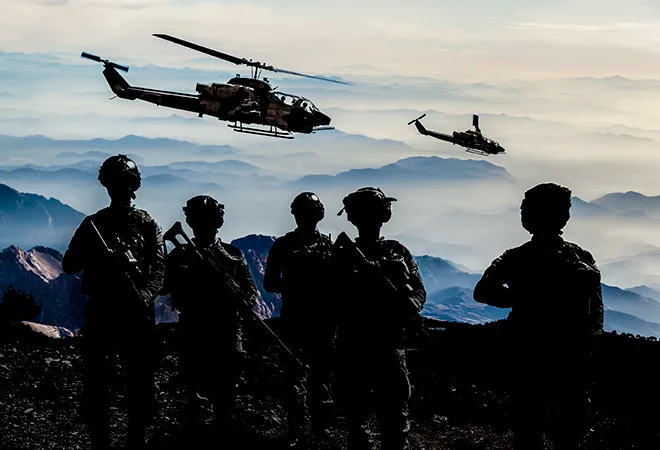
In his speech to the Democratic National Convention in the United States on 20 August, Barack Obama broke with the convention of former presidents maintaining a dignified silence about their successors, and blasted President Donald Trump of treating the US presidency “as anything but one more reality show that he can use to get the attention he craves.”
The 3 November election will decide the fate of the Trump presidency — and the reality show it often resembled. Yet, among the feats the President will want to highlight as his signal achievement in the first term would be one on the foreign policy front: the 29 February peace deal with the Taliban that charted the roadmap of Afghan national reconciliation leading to the complete withdrawal of all American and NATO troops from the country in 14 months after nearly two decades of military engagement. The US has already closed several bases and will have fewer than 5,000 troops in Afghanistan by the end of the year from 12,000.
Predictably, Obama’s withering attack drew sharp response from Trump, who retorted that it was thanks to his predecessor’s “ineffective, terrible” presidency that he was elected the President. “Now President Obama did not do a good job, and the reason I’m here is because of President Obama and Joe Biden. They did such a bad job that I stand before you as president.”
His (Obama’s) administration initially tried nation-building in tandem with the military enterprise to vanquish the Taliban, following the footsteps of President George W. Bush, but that did not work.
That criticism is also justified, because many of Obama’s policies were washouts. Consider his administration’s fumbled response to the conflict in Afghanistan, a war zone that had direct bearing on US military. He had come to office in 2009 vowing to end what he frequently termed a war of necessity. His administration initially tried nation-building in tandem with the military enterprise to vanquish the Taliban, following the footsteps of President George W. Bush, but that did not work. Then the administration changed tack and tried the clear, build, hold transfer military policy to counter the upsurge in Taliban insurgency, but that too came up short. At the time of the much-hyped Afghan troop surge announcement in 2009, President Obama set 2011 as the deadline to withdraw US troops from Afghanistan. The troops surge was a damp squib and failed to achieve the result. Two top military commanders in Afghanistan had been fired after clashing with the administration over war policy amid mounting setbacks.
Then came another deadline. As Obama’s Vice President, the current Democratic presidential candidate Joe Biden declared to much media fanfare in December 2010 that US troops would start leaving Afghanistan from the summer of 2012. Biden was blunt: “We'’e going to be totally out of there, come hell or high water, by 2014.” One month later, on a visit to Afghanistan and Pakistan, the gaffe-prone Biden had to walk back on the damaging statement he had made, salting it with the escapist qualifier that if the Afghan people want it, US troops would not leave the country in 2014.
In the 2014 State of the Union address, President Obama declared that the war in Afghanistan “is finally coming to an end.” It never did. When Obama’s two terms in office drew to a close in January 2017, his administration meekly handed over a foreign policy crisis to the Trump administration. The Afghan strategy was in tatters — far from breaking the Taliban’s momentum, the US was clueless how to stop their victory march. By that time, Afghanistan had snagged the title of American’s longest war — which American commanders themselves admitted as stalemated.
Stalemate meant a steady loss of territory by the US-backed weakly regime whose corrupt, demoralised and desertion-prone military forces were getting outflanked by the insurgency.
Stalemate was an eerie word for US generals to use after 16 years of involvement. In fact, stalemate meant a steady loss of territory by the US-backed weakly regime whose corrupt, demoralised and desertion-prone military forces were getting outflanked by the insurgency. One plan that underpinned the American strategy in Afghanistan was to create a strong Afghan National Security Forces (ANSF) as the bulwark to prevent an Islamist takeover of the country when the US-led NATO troops leave the country. With ferocious attacks financed by narcotics trade and Pakistan’s support, the Taliban had significantly expanded territory under its control, demoralised the ANSF and tread on US toes. A report released early in January 2017 by the US Special Inspector General for Afghanistan Reconstruction (SIGAR) made clear that despite the Pentagon pouring some $70 billion into arming and training the ANSF, the force was steadily losing ground to insurgent groups, while suffering record casualties. The report cited wholesale corruption and mass desertions as major reasons for this.
President Trump, who inherited a mess from Obama, had no pretensions about expanding freedom and western style democracy at gunpoint in Afghanistan, which anyway had long been stalled. He was a president who promised never to invade a country as an act of stupidity as many of his predecessors did to the enormous cost of American blood and treasure. He recognised that it was a war without victory, as he termed it in the August 2017 announcement of his administration’s Afghan strategy. He knew that cutting a deal with Taliban was the only way out to bring the curtains on a war that began even before he embarked on his TV reality show career. He understood that it is futile to prolong the presence of US military in Afghanistan for the sake of propping up an ineffective government in Kabul. His strategy put American security interests above all other considerations — primarily, to prevent Afghanistan becoming a safe haven for jihadi thugs to plot and direct attacks on the US soil. For good measure, he had boasted that if bad things happen, the US go back “with a force like no-one’s ever seen.”
Will the Trump administration’s peace deal with the Taliban hold up? The looming danger is that the President’s eagerness to tout the deal as a success would precipitate a hasty US withdrawal, against which he himself warned in his strategy speech in 2017. Mistakes are already being made in this direction. To remove the last hitch in the path of direct talks between them in the most critical phase of the peace process that would take place in the next few weeks, the Afghan government had to release hundreds of Taliban mass murderers (out of the total 5,000 prisoners released) in a move that has drawn widespread condemnation. The Taliban will reach the negotiation table with battlefield supremacy and a ceasefire is far off. It is not clear whether the Taliban, who insist they will return Afghanistan to an Islamic emirate, will ever share power. They have not committed themselves to a constitutional, pluralistic political system where human rights and liberties are respected in the future.
The Taliban will reach the negotiation table with battlefield supremacy and a ceasefire is far off. It is not clear whether the Taliban, who insist they will return Afghanistan to an Islamic emirate, will ever share power.
Besides, why would Pakistan let the Afghan peace process move forward unless it is on terms it likes? Amid suspicions that Pakistan is complicit in the resurgent Islamic State mayhem in Afghanistan, last week’s a realignment of forces in a jihadi terror outfit, with two splinter groups Jamat-ul-Ahrar and Hizb-ul-Ahrar reuniting with the Tehreek-i-Taliban Pakistan, appears significant, though the group so far only targeted Pakistani security forces and civilians. Pakistan still remains “safe haven to agents of chaos, violence and terror,” as President Trump had put it in August 2017, among them the powerful Haqqani Network of the Taliban.
The February peace deal is billed as the best chance at ending decades of war in Afghanistan. But only time will tell if it lives up to expectations or wound up as another reality show episode.
The views expressed above belong to the author(s). ORF research and analyses now available on Telegram! Click here to access our curated content — blogs, longforms and interviews.




 PREV
PREV


